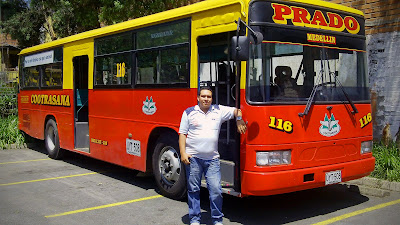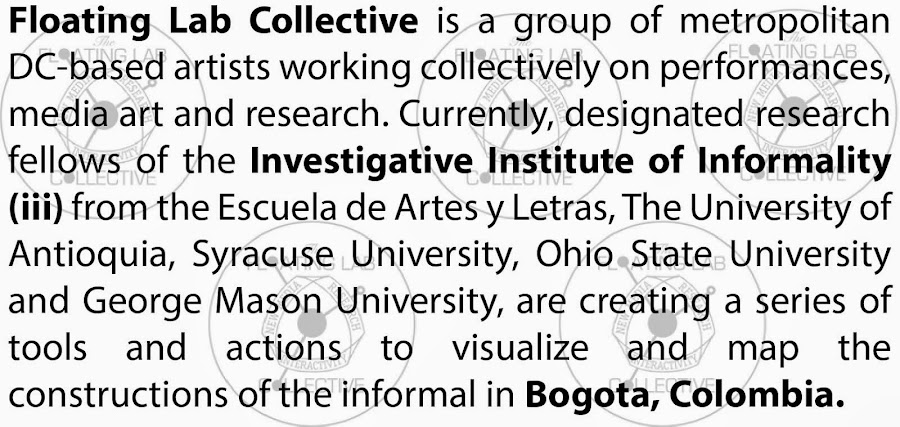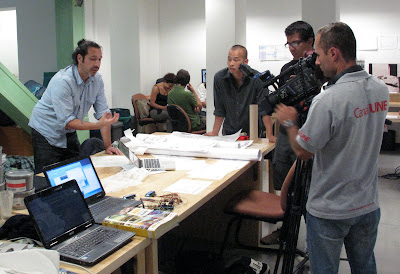El Moro, the Mound of Moravia
Blow Rasta
Blow Rasta_Medellin - Colombia, 2011 from i3m on Vimeo.
Estudio Movil: Moravia
The Collective White House : Under Construction

Los Alabaos


Embroidery at the Moravia Cultural Center

Metal Shop
Shopping Spree




We wandered through the police mini-mall and the military mini-mall looking for fifteen pairs of white ‘parade’ gloves, size large. We found them, but only after distractedly learning about batons, guns, protective footwear and how to join a mercenary organization. After that we found a source for large rubber stamps, embroidery thread, buttons and various colored pens.
The gloves are now being embroidered based on a selection of handmade maps drawn by citizens in neighborhoods adjoining the five major libraries built by the city to activate formerly marginalized communities. Roads are in black, zones of affection are green and zones of conflict are red.
Above are some of the glove drawings we collected.Agencia de Lenguaje Urbano (Agency of Urban Language)
Escritores (writers on the street)


In The News
Meeting the Rappers and a Dog Takes Shape


Stories of the Minuteros

"I am Urabá, I came to Medellín with my family displaced by violence. Working in the Park for two years Berrio. At my age and my disability gives me no work. Coming to the park told me that if someone wanted to sell minutes, and I accepted. I knew nothing about phones and stuff, but I got it. "
This is the classic story of a Minutero. Minuteros carry cell phones that are attached to vest, they sell the minutes for about $.08 USD. The minutero occupation provided steady work and a relatively smooth transition from a period of violent conflict. In the past few years the minuteros workforce has come to represent the unemployed, young children who cannot afford schooling (typically female), displaced peoples from the surrounding area.
The minutero is an archive of the social meme, a depository for the daily interactions of people in Medellin. The stories that they hear provide us with a context with which to view the city. We invited the minuteros to recount their stories and be projected on Collective White House. The stories they tell are personal, funny, and touch on the complex political situation in the area the museum.
The Mobile Studio : Bus 116


Cultural Center of Moravia


Just recently we met with the a group of embroiders from the Cultural Center of Moravia (CCM). Director, Carlos Uribe succinctly explains the history of the neighborhood:
Moravia is a young neighborhood in Medellín that has been in existence for 42 years. It sprung up in 1968 as an unplanned development and is, let’s say, a unique phenomenon. Moravia grew around a rubble deposit that later became a garbage depository and subsequently the city’s official garbage dump, due to errors within the government administration during the seventies.
Between 1973 and 1983, the government authorized the dumping of any and all waste: residential, human, hospital and industrial. This created an infectious mish-mash, a mixture of different types of waste, including radioactive waste. Paradoxically, due to the social problems stemming from Colombia’s armed conflict, unplanned development processes led to Medellín becoming the focus of many displaced subsistence farmers, indigenous people, those of African descent and people from other parts of the country looking for a better life. They all concentrated around that garbage dump, living off recycled materials.
In that epicenter of death rose an epicenter of life. Moravia is a community of 48,000 inhabitants living in a very small area, a neighborhood that has the highest population density in Colombia: a unique phenomenon. Apart from overcrowding, public services used as contraband, lack of schooling and intra-family violence, Moravia also has positive features, such as being a melting pot of cultures. The people who come from the north and south of the country, the Pacific or the Llanos give it a very wide-ranging cultural richness. Part of our responsibility is to make those memories, that identity, that culture, come to light."
What Carlos Uribe describes is a social and economic context for which we base our project. Uribe's Cultural Center provides a structure for the artisans of Moravia that counter-balances their landscape poverty, drugs and exclusion from responsible social services. CCM marks a literal and symbolic space where people of the community can work as a collective to change the social issues that plaque their area. For those who come to the center there is more to find than lessons in cultural practices.CCM provides a foundation that creates a local economic structure, an education system, and an understanding of the collective process for social change.
We have initiated a project with a group of embroiders at the Cultural Center of Moravia. All total, thanks to a generous donation by Carlos Uribe, we have commissioned 12 members of the group to embroider 12 graphic images on bed sheets to be displayed within the Collective White House. Our interest in collaborating with the embroidery group comes from our interest in the process of embroidery as a contemporary art process, and a commitment to the local economic process as generated by CCM.





